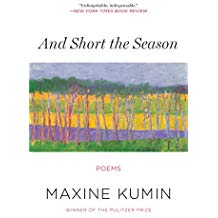And Short the Season: Poems, Maxine Kumin 2014
This is Kumin’s 18th and final book of poems, and she once again, revealed why I’ve always prized her among my favorite poets. Contributing to my love of her work is her Jewish upbringing in a largely Christian environment (one of her poems addresses her use of the rosary at her Catholic school), her years at Radcliffe in the 50’s, and her strong identification with her NH farm. These poems address her long time themes of nature, family, art and literature, and illness, failing health, dying, and death. There is also a strong element of the political with poems decrying torture in Iraq and Afghanistan and the presence of Guantanamo. I loved the poem ‘Xanthopsia” which means a distorted emphasis on the color, yellow, that talks about Van Gogh’s paintings and obsessions. Her poem about Thomas Hardy and Michael Jackson juxtaposes two unlikely artists quite effectively. My favorites, however, are the first two poems which dwell on the natural world of her NH farm. ‘Whereof the Gift is Small’ utilizes quotes from the Earl of Surrey’s 16th C sonnet to contrast the beauty of spring and its endless cycle with the finite lifespan of the poet: “….brittle beauty—-might this be the last.” In “The Path, The Chair” she writes “Forty years of trudging the bounds/of our fields” and “Saving is a form of worship: the restored fields,/the rescued dogs, the ancient horses/named Genesis and Deuteronomy,/Eden, Praise Be, Hallelujah, and the farthest field/saluting the Greek gods and goddesses,/our catholic homage to an afterlife/we like the thought of but don’t believe in.” I, too, often think lovingly about the 31 years trudging our fields in Vermont, and her reference to long-dead horses echos my favorite, Donald Hall. The final poem in the book is one which I will copy and keep on my desk, Allow Me: Sudden and quiet, surrounded by friends/—John Milton’s way—-/But who gets to choose this ordered end/Trim and untattered, loved ones at hand?/—-Allow me that day. I also love the cover painting by Wolf Kahn.



